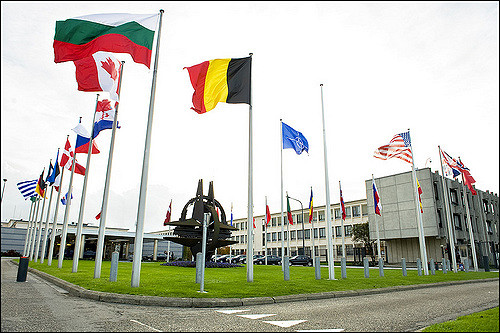Shortly before departing for what will likely be a tense summit in Brussels followed by a closely watched meeting with Russian President Vladimir Putin, Trump expressed disappointment with America’s allies. “The United States is spending far more on NATO than any other Country. This is not fair, nor is it acceptable. While these countries have been increasing their contributions since I took office, they must do much more,” the president tweeted.
In recent weeks, Trump has reportedly flirted with the idea of decreasing the U.S. military presence in Europe if certain NATO members continue to fall short of the agreed-upon goal of spending 2 percent of GDP on defense. The threat has raised concerns among some transatlantic allies that Trump may undermine U.S. support for NATO’s renewed deterrent posture against Russia.
Trump reportedly sent letters to the leaders of Germany, Italy, Norway and Canada warning, “It will become increasingly difficult to justify to American citizens why some countries continue to fail to meet our shared collective security commitments.”
In June, Trump sent a letter to German Chancellor Angela Merkel, obtained by The New York Times, asserting America’s “growing frustration” with Germany. The letter fueled rumors that the U.S. was planning to draw down some of its 35,000 troops currently stationed in the country. According to the U.S. ambassador to NATO, there are currently no plans to alter the U.S. troop alignment in Germany.
“The United States continues to devote more resources to the defense of Europe when the Continent’s economy, including Germany’s, are doing well and security challenges abound. This is no longer sustainable for us,” Trump warned.
DEFENSE SPENDING
Over the weekend, NATO Secretary General Jens Stoltenberg credited President Trump with creating the conditions for the largest combined increase in NATO defense spending in nearly 25 years.
“The upswing in NATO defense spending over the past year and a half demonstrates that his [President Trump’s] efforts are making a difference,” Stoltenberg wrote in a Wall Street Journal editorial. “There is still a long way to go, but NATO members have turned the corner on defense spending.”
Since President Trump took office calling on NATO members to pay their fair share, all but one of the 29 members has increased its defense spending. Last year, the alliance collectively increased military spending by 5.2 percent, or approximately $14.4 billion.
The number of NATO allies spending at least 2 percent of GDP on national defense increased this year to eight (the United States, the United Kingdom, Greece, Estonia, Latvia, Lithuania, Poland and Romania) up from only three in 2014. By 2024, 18 allies are expected to meet their 2 percent pledge.
“NATO really is making progress and they are doing it really at President Trump’s insistence,” U.S. Ambassador to NATO Kay Bailey Hutchison said on Fox News Sunday. This year will mark the fourth consecutive year of NATO defense spending increases.
At NATO’s 2014 summit in Wales, allies agreed to meet the 2 percent target “within a decade.” The commitment was intended to counter Russia’s renewed aggression following its annexation of Crimea and put a halt to years of defense budget cuts in Europe and North America in response to the 2008-2009 global financial crisis.
The agreement also included a pledge by members to spend 20 percent of their defense budgets on new military equipment, research and development to prevent obsolescence.
There are now about a dozen members who have met the 20 percent benchmark with many of them investing in U.S.-made hardware, like the Lockheed Martin F-35 fighter jet and advanced missile defense systems. According to Stoltenberg, 22 allies are expected to meet the goal of investing in new equipment by 2024.
The United States continues to shoulder the lion’s share of defense spending, with more than 3.5 percent of GDP dedicated to the military budget. Collectively, all 29 member states spent $917 billion on defense in 2017. The U.S. defense budget accounted for roughly 67 percent of that total.
INCREASED INVESTMENT IN READINESS
Despite the concerns about President Trump’s tweets and letters, NATO leaders are expected to sign significant agreements this week aimed at deterring Russian aggression and continuing to rebuild the overall capabilities of NATO.
At the time of Russia’s annexation of Crimea, U.S. military presence in Europe had decreased from its Cold War height of roughly 200,000 troops to about 33,000. That trend has started to reverse in recent years with increased defense spending from allies and more substantial commitments from the United States.
Ambassador Hutchison told reporters last week that she expects a “very substantive” outcome in Brussels. “I think it is going to be one of the most productive that we have ever had,” she added.
Members are expected to commit to a “thirty times four” readiness initiative calling on allies to assemble 30 land battalions, 30 air squadrons and 30 combat vessels capable of deploying in 30 days or less. The alliance intends to stand up the forces by 2020.
NATO leaders are also expected to approve a new command structure with an Atlantic maritime command headquartered in Norfolk, Virginia and a land-based logistical command headquartered in Germany.
Additionally, the United States has consistently increased its support for Operation Atlantic Resolve, a U.S.-led NATO effort aimed at deterring Russia and strengthening the alliance’s eastern flank. Under President Barack Obama, the Pentagon was given roughly $1.8 billion between 2015 and 2016 for the European Reassurance Initiative, a program to restore America’s military footprint in Europe after spending the post-Cold War years drawing down U.S. troops and equipment.
Under Trump, the renamed European Deterrence Initiative was funded at $3.4 billion in 2017 with $4.7 billion requested in 2018 and $6.5 billion requested for 2019. The program has funded more frequent military exercises, increased rotational deployments of U.S. forces in Poland, Romania, Norway and the Baltic States and new equipment prepositioned in countries that share a border with Russia.
Late last year, President Trump also authorized the sale of offensive weapons to Ukraine to defend against Russia, reversing the position of the Obama administration.
“I think this is one case definitely where you want to look at the actions and not the tweets,” said Stephen Flanagan a senior political scientist at the RAND Corporation and former National Security Council staffer.
In terms of the U.S. military posture towards Russia, the reality on the ground is quite different from what is often portrayed in the media as a closeness between President Trump and Russian President Vladimir Putin.
Still, one of the concerns leading into the Brussels summit is what will happen in the days after, when Trump is scheduled to meet Putin in Helsinki.
Allies are worried that if the NATO summit ends with the same acrimonious tone as the recent G-7 summit it could send a signal that the alliance is not unified, something Vladimir Putin and past Russian leaders have long sought to exploit, Flanagan explained.
“This is where the bigger strategic danger is, that if the meeting is divisive it will suggest the alliance is divided,” he noted. “That is one thing those who have long supported NATO and the transatlantic relationship are most worried about.”






